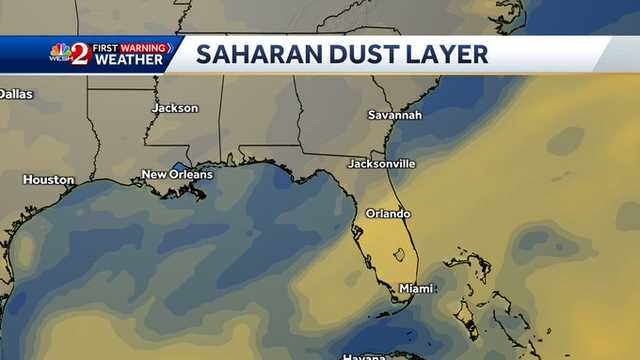Waves of Saharan dust are sweeping over Florida, with plumes expected to continue arriving every three to five days, according to Ross Giarratana, a meteorologist with the National Weather Service’s Tampa Bay forecast office. This influx of dust brings the possibility of “dirty rain,” which, while it sounds concerning, is harmless.

Understanding Saharan Dust
Saharan dust consists of fine particles of dust and sand from Africa, carried across the Atlantic Ocean by trade winds. These winds lift the dust into the atmosphere, transporting it thousands of miles to places like Florida. This natural phenomenon peaks during June and July, bringing the most dust across the ocean during these months. The phenomenon is not new, but increased meteorological capabilities have made it easier to predict and track the dust’s movement, leading to more public awareness.
The Phenomenon of ‘Dirty Rain’
As rain droplets form in the atmosphere, they tend to gather around various particles, including Saharan dust. When it rains, these dust-laden droplets fall to the ground, resulting in what is commonly referred to as “dirty rain.” Alex DaSilva, AccuWeather’s lead hurricane forecaster, explains that the term “dirty rain” is rarely used by the National Weather Service, which generally refers to it simply as Saharan dust. The rain may leave streaks on cars and other surfaces, but it is harmless. Unlike acid rain, which contains toxic pollutants, dirty rain merely contains dust particles and poses no threat to human health. However, it is advised not to drink the rainwater.
Health Implications and Safety Measures
While Saharan dust and dirty rain are generally harmless, they can pose issues for individuals with respiratory conditions like asthma. If high concentrations of dust remain in the lower atmosphere, it may exacerbate breathing problems for these individuals. It is important for those affected to stay informed about air quality conditions in their area. The National Weather Service and local governments will issue air quality alerts if dust concentrations reach potentially harmful levels. Fortunately, Saharan dust usually remains high in the atmosphere, minimizing its impact on air quality at ground level.

South Florida, including Miami and Fort Lauderdale, has already experienced a dirty rain shower, with areas in the panhandle potentially next in line. However, residents need not worry about health risks from these weather events. The primary concern remains the temporary inconvenience of dust streaks on surfaces. While Saharan dust brings the occasional dirty rain to Florida, it is a natural and largely harmless phenomenon. Residents should remain informed about air quality, especially those with respiratory issues, but can otherwise continue with their daily activities without concern.
